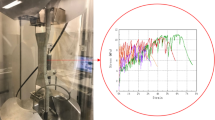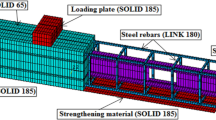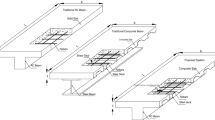Abstract
Composite-reinforced concrete/steel beams (CRCSB) have been commonly used due to the ability of composite sections to carry high loads with minimal material. Despite the considerable improvement made in the last decade to understand the effect of shear connectors between concrete and steel on CRCSB response, there is a lack in understanding how these connectors affect the cracks propagation and widened along the slab. Herein, an experimental investigation focusses on the behavior of CRCSB under flexure was presented. This paper aimed to investigate two main aspects: the effect of bearing stiffeners and shear connectors shapes on the failure mechanism and ultimate capacity of the CRCSB. Accordingly, five full-scale CRCSB were fabricated and evaluated under four-point bending. Four types of connecters are used (bolts, C-channels, angles and angles synergized by bolts). To precisely predict the number of shear connectors and maximum shear resistance of CRCSB, a new factor \({\gamma }_{SA}\) was adopted based on the theoretical and experimental findings. The observed cracks, strain, failure mechanism and load–displacement were recorded during the test and a qualitative comparison was presented. Experimental results revealed that the shear connector shape was the key factor influencing the concrete part performance. The failure of specimens was dominant by the strut and tie mechanism in pure bending zone. The CRCSB with bolts experienced the highest loads capacity while the two CRCSB had angles or angles and bolts as shear connectors gained nearly the same toughness.













Similar content being viewed by others
References
AASHTO: AASHTO LRFD bridge desing Specification. American Association of State Highway and Transportation Officials, Washington, DC, USA (2012)
Ataei, A.; Zeynalian, M.: A study on structural performance of deconstructable bolted shear connectors in composite beams. Structures. 29, 519–533 (2021). https://doi.org/10.1016/j.istruc.2020.11.065
EN1994-1-1:2004, Eurocode-4: design of composite steel and concrete structures Part 1.1. European Committee for Standardization (CEN), Brussels, Belgium (2004)
Baran, E.; Topkaya, C.: Behavior of steel-concrete partially composite beams with channel type shear connectors. J. Constr. Steel Res. 97, 69–78 (2014). https://doi.org/10.1016/j.jcsr.2014.01.017
Salih, M.N.A.; Tahir, M.M.; Mohammad, S.; Ahmad, Y.; Shek, P.N.; Abraham, A.; Firdaus, M.: Khadavi: bending experiment on a novel configuration of composite system using rebar as shear connectors with partially encased cold-formed steel built-up beams. Mater. Today Proc. 39, 999–1005 (2019). https://doi.org/10.1016/j.matpr.2020.04.647
Dai, X.; Lam, D.; Sheehan, T.; Yang, J.; Zhou, K.: Effect of dowel shear connector on performance of slim-floor composite shear beams. J. Constr. Steel Res. 173, 106243 (2020). https://doi.org/10.1016/j.jcsr.2020.106243
Dias, J.V.F.; Carvalho, H.; Rodrigues, F.C.; Maia, K.A.F.P.; Caldas, R.B.: Experimental and numerical study on CFS composite beams with riveted shear connectors. Structures 33, 737–747 (2021). https://doi.org/10.1016/j.istruc.2021.04.058
Ataei, A.; Bradford, M.A.; Liu, X.: Experimental study of composite beams having a precast geopolymer concrete slab and deconstructable bolted shear connectors. Eng. Struct. 114, 1–13 (2016). https://doi.org/10.1016/j.engstruct.2015.10.041
Huo, J.; Wang, H.; Li, L.; Liu, Y.: Experimental study on impact behaviour of stud shear connectors in composite beams with profiled steel sheeting. J. Constr. Steel Res. 161, 436–449 (2019). https://doi.org/10.1016/j.jcsr.2018.04.029
Yang, T.; Liu, S.; Qin, B.; Liu, Y.: Experimental study on multi-bolt shear connectors of prefabricated steel-concrete composite beams. J. Constr. Steel Res. 173, 106260 (2020). https://doi.org/10.1016/j.jcsr.2020.106260
Anju, T.; Smitha, K.K.: Finite element analysis of composite beam with shear connectors. Procedia Technol. 24, 179–187 (2016). https://doi.org/10.1016/j.protcy.2016.05.025
Wijesiri Pathirana, S.; Uy, B.; Mirza, O.; Zhu, X.: Flexural behaviour of composite steel-concrete beams utilising blind bolt shear connectors. Eng. Struct. 114, 181–194 (2016). https://doi.org/10.1016/j.engstruct.2016.01.057
Classen, M.: Limitations on the use of partial shear connection in composite beams with steel T-sections and uniformly spaced rib shear connectors. J. Constr. Steel Res. 142, 99–112 (2018). https://doi.org/10.1016/j.jcsr.2017.11.023
Alves, A.R.; Isabel, B.V.; Washintgon, B.V.; Gustavo, S.V.: Prospective study on the behaviour of composite beams with an indented shear connector. J. Constr. Steel Res. 148, 508–524 (2018). https://doi.org/10.1016/j.jcsr.2018.06.015
Bamaga, S.O.; Tahir, M.M.; Tan, C.S.; Shek, P.N.; Aghlara, R.: Push-out tests on three innovative shear connectors for composite cold-formed steel concrete beams. Constr. Build. Mater. 223, 288–298 (2019). https://doi.org/10.1016/j.conbuildmat.2019.06.223
Bonilla, J.; Bezerra, L.M.; Mirambell, E.: Resistance of stud shear connectors in composite beams using profiled steel sheeting. Eng. Struct. 187, 478–489 (2019). https://doi.org/10.1016/j.engstruct.2019.03.004
Lima, J.M.; Bezerra, L.M.; Bonilla, J.; Barbosa, W.C.S.: Study of the behavior and resistance of right-angle truss shear connector for composite steel concrete beams. Eng. Struct. 253, 113778 (2022). https://doi.org/10.1016/j.engstruct.2021.113778
Bezerra, L.M.; Barbosa, W.C.S.; Bonilla, J.; Cavalcante, O.R.O.: Truss-type shear connector for composite steel-concrete beams. Constr. Build. Mater. 167, 757–767 (2018). https://doi.org/10.1016/j.conbuildmat.2018.01.183
Bezerra, L.M.; Cavalcante, O.O.; Chater, L.; Bonilla, J.: V-shaped shear connector for composite steel-concrete beam. J. Constr. Steel Res. 150, 162–174 (2018). https://doi.org/10.1016/j.jcsr.2018.07.016
Braconi, A.; Elamary, A.; Salvatore, W.: Seismic behaviour of beam-to-column partial-strength joints for steelconcrete composite frames. J. Constr. Steel Res. 66, 1431–1444 (2010). https://doi.org/10.1016/j.jcsr.2010.05.004
Elamary, A.; Ahmed, M.M.; Mohmoud, A.M.: Flexural behaviour and capacity of reinforced concrete–steel composite beams with corrugated web and top steel flange. Eng. Struct. 135, 136–148 (2017). https://doi.org/10.1016/j.engstruct.2017.01.002
ACI: 211.1–91: Standard practice for selecting proportions for normal, heavyweight, and mass concrete. Farmington Hills, MI, USA (1991)
American Society of Civil Engineers-(ASCE): standard for the structural design of composite slabs and standard practice for construction and inspection of composite slabs. American Society of Civil Engineers (1994)
BS 5950-3.1: 1990: Structural use of steel work in buildings: part 3: Section 3.1: code of practice for design of simple and continuous composite beams (1991)
Ding, F.-X.; Liu, J.; Liu, X.-M.; Guo, F.-Q.; Jiang, L.-Z.: Flexural stiffness of steel-concrete composite beam under positive moment. Steel Compos. Struct. 20, 1369–1389 (2016). https://doi.org/10.12989/scs.2016.20.6.1369
Tadesse, Z.; Patel, K.A.; Chaudhary, S.; Nagpal, A.K.: Neural networks for prediction of deflection in composite bridges. J. Constr. Steel Res. 68, 138–149 (2012). https://doi.org/10.1016/j.jcsr.2011.08.003
Gupta, R.K.; Kumar, S.; Patel, K.A.; Chaudhary, S.; Nagpal, A.K.: Rapid prediction of deflections in multi-span continuous composite bridges using neural networks. Int. J. Steel Struct. 15, 893–909 (2015). https://doi.org/10.1007/s13296-015-1211-9
ACI: 318–08: Building code requirements for structural concrete and commentary. American Concrete Institute (2008)
CEN- EN: Eurocode 1992-1-1: design of concrete structures. European Committee for Standardization (1992)
Matamoros A.B.; Wong K.H.: Design of simply supported deep beams using strut-and-tie models. ACI Struct. J. 100(6), 704–712 (2003)
Braconi, A.; Elamary, A.; Salvatore, W.: Improvement of seismic performance of steel-concrete composite joints by means of slab-column shear connection. In: Proceedings of the 12th Italian National Conference of Earthquake Engineering, PISA (2007)
Acknowledgements
This work was supported by the Taif University Researchers Supporting Project Number (TURSP-2020/276), Taif University, Taif, Saudi Arabia. The funding source was not involved in study design; in the collection, analysis and interpretation of data; in the writing of the report; and in the decision to submit the article for publication.
Author information
Authors and Affiliations
Corresponding author
Ethics declarations
Conflict of interest
The authors do not have any conflicts of interest to declare.
Appendices
Appendix 1
Maximum Capacity of Manufactured Specimen
2.1 Using Proposed Factor of Safety
See Fig.
14.
Rights and permissions
Springer Nature or its licensor (e.g. a society or other partner) holds exclusive rights to this article under a publishing agreement with the author(s) or other rightsholder(s); author self-archiving of the accepted manuscript version of this article is solely governed by the terms of such publishing agreement and applicable law.
About this article
Cite this article
Alharthi, Y.M., Sharaky, I.A., Elamary, A.S. et al. Flexural Behavior and Capacity of Composite Concrete-Steel Beams Using Various Shear Connectors. Arab J Sci Eng 48, 5587–5601 (2023). https://doi.org/10.1007/s13369-022-07485-y
Received:
Accepted:
Published:
Issue Date:
DOI: https://doi.org/10.1007/s13369-022-07485-y





